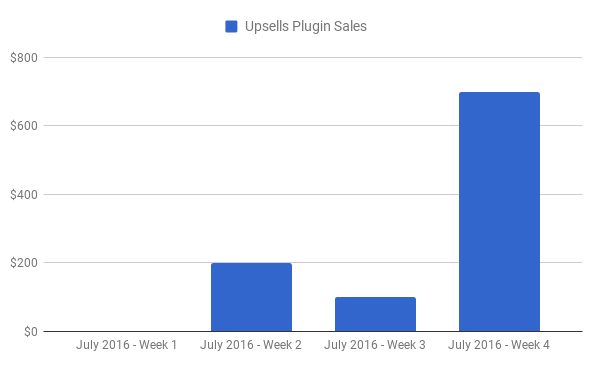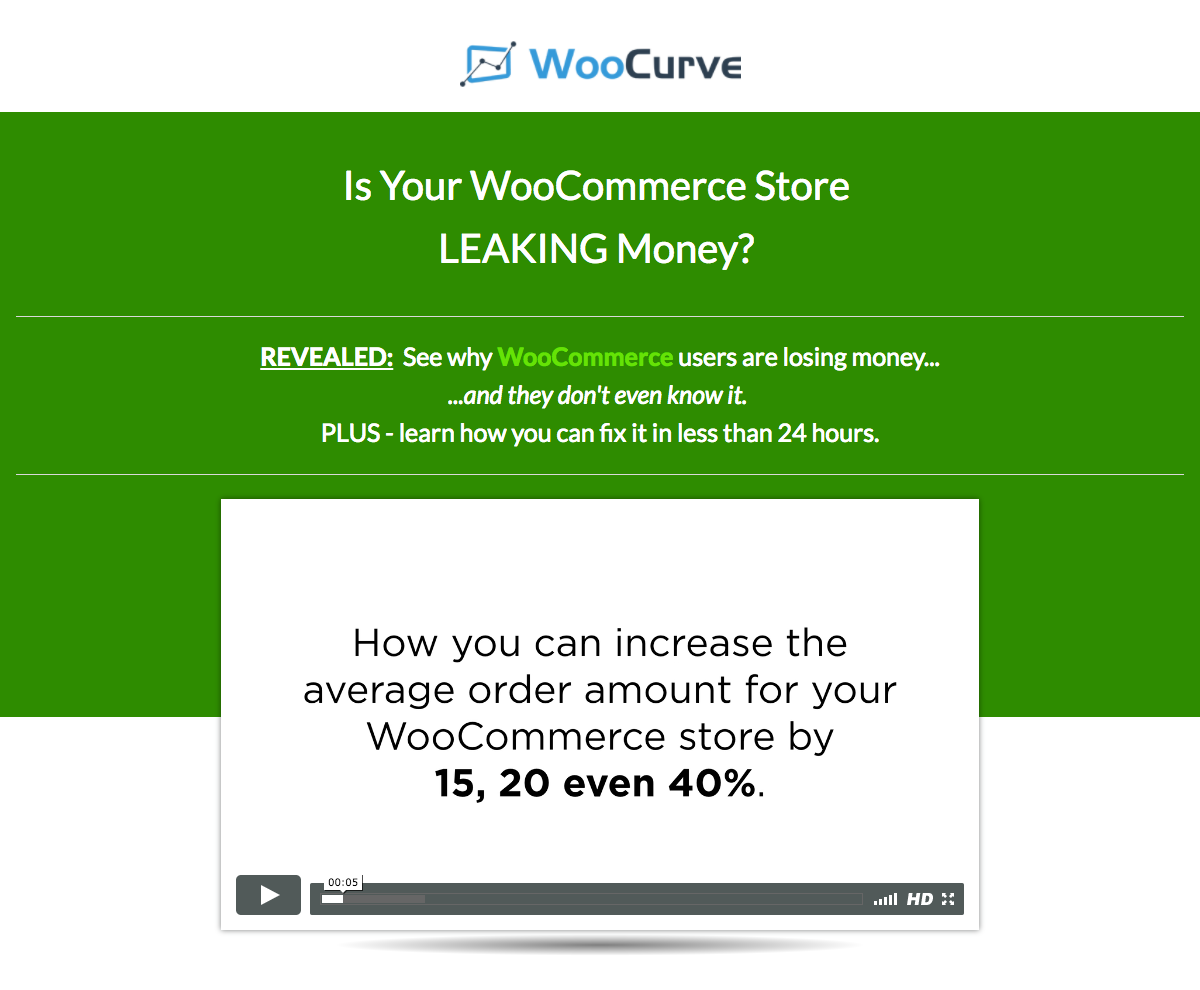
How do you launch a product in a crowded market when you have no name recognition, no track record, no website, no ad budget, and no email list?
Even more, how do you get potential customers to actually pay you to build the product?
Hi, my name is Chris Mason, and these are the exact problems my partner Bogdan and I solved when we launched our first product. At WooCurve we build products that make WooCommerce — an e-commerce plugin for WordPress sites — way better.
We were able to take our very first product, One Click Upsells, from $0 and no product to $1,000 in revenue in 30 days.
Today I'm going to share with you exactly how we did it.

But first, let me tell you why I'm sharing this with you.
For years I worked a high-paying job that most people would have killed for. It provided a great lifestyle for my family (I'm married with two little kids), but something felt off.
I wanted something more.
I wanted unlimited upside and location independence. I wanted to try my hand at building a business. It was all I could think about.
So, like a lot of people, I worked nights and weekends trying to come up with product ideas that might eventually allow me to leave my day job. Over an 18 month period, I launched four different products, and they all failed. I actually lost money.
But I also learned a lot about what does and doesn't work when launching a product. Those are some of the lessons you'll see below.
Finding a Hungry Market
Fast forward a little.
I decided to change things up, and I started consulting on the side instead of building products. After I acquired a few clients, consulting turned out to be the means by which I was able to leave my day job.
I still wanted to build products, but consulting provided a faster path to cash.
My expertise is in writing highly effective sales copy and setting up marketing automation sequences that get customers to buy. The kids today call them funnels. :-)
So when I started working with a client who was setting up a WooCommerce store, I knew very little about WooCommerce, but I knew a lot about the key ingredients of top-performing funnels.
Here's what you need, at the very least:
- desirable product or service to sell
- good sales copy for your offer
- method of collecting payment from buyers, e.g. a checkout page
- one-click sequence for upselling and downselling
That last ingredient is crucial. Some of the funnels I've built are only profitable because of the upsell sequence. Those particular funnels had to be "one-click," meaning that customers didn't have to re-enter their credit card information.
However, as I began to work with WooCommerce, I discovered something peculiar.
There was no tool that would allow me to offer upsells and downsells the way I wanted. I think I searched nearly every WooCommerce forum, blog, and Facebook group looking for the solution, but I turned up empty handed.
However, I did discover something else that was unexpected: There were lots and lots of people just like me looking for this same solution.
Interesting.
Through one of the forums, I connected with a developer who'd noticed the same level of interest. We thought, "What if we reached out to some of the people in these forums and built a barebones product for them?"
The two of us would eventually become business partners.
Tapping the Breaks
At this point, my mind went back to those other products I'd launched. Remember? The ones that failed and cost me money?
A little voice inside my head started coming up with reasons why starting this business was a bad idea, too. Steven Pressfield in his book The War of Art calls this voice "The Resistance."
And there's a good chance that voice would have won if not for my secret weapon.
See, as a result of the painful experiences of launching failed products, I had developed a checklist to help me decide if a product idea was worth pursuing. So I didn't have to think. All I had to do was see how the idea held up against this checklist.
I called it the "Product Greenlight Framework," and it was a set of yes/no criteria that must be met before moving forward on a product. In other words, if you can't answer yes to every question below, move on.
- [Y/N] Is there demand for the product, and how do you know?
- [Y/N] Is there a competitor?
- [Y/N] Will someone pay for it right now?
Admittedly, the first of the criteria isn't as black and white as the other two. For that one, I look for things such as forum activity. Is there a dedicated, active thread on the topic? Can I easily find and talk to people who are trying to solve the problem my product will solve?
Now that you've seen a high-level overview of the framework I use, let me show you how we used it to launch our One Click Upsells product and, ultimately, the company we have today.
The "Product Greenlight Framework" for One Click Upsells
1. Is there demand for the product?
We spent several hours searching through WooCommerce forums and WooCommerce Facebook groups, and conducting various Google searches. What we found were other people like us who wanted a one click upsells solution, but no one was providing it.
In fact, I could point to a dedicated forum thread on the WooCommerce site itself where people were begging for this solution. Plus there were others in Facebook groups and various blog post comments. These were people we could reach out to directly.
So we knew there was demand… but how much?
2. Is there a competitor?
You want this answer to be “YES.” Competition is good, because if someone else is making money off of the idea, it means there could be room for you.
If you're launching a product with no competition, you need to find out why. Have people tried and failed? If the idea is so good, why isn't anyone else in the space? As much as we like to think our ideas are unique, the chances of you or I coming up with a truly original product are slim to none.
In our case, there actually wasn't a direct competitor serving the WooCommerce market. But having worked on other non-WooCommerce platforms, I knew how essential one click upsells were. You can look at platforms like SamCart, ClickFunnels, and others to see that the ability to offer one click upsells is non-negotiable.
So even though we couldn't point to a competitor in our exact niche, we could point to WooCommerce competitors who offered a product or feature that was similar to the one we were thinking about.
3. Will someone pay for it right now?
This is the most important part of the framework. Even if your product or idea passes the other two hurdles, if it doesn't pass this one, run.
You are in danger of wasting your time.
This is also the hardest part for most people. They're uncomfortable asking for money. But the faster you can find out if someone will pay for your product, the faster you know if it's worth your time.
There are two schools of thought on this. Either you pre-sell your product to your target customer before you have it built, or you create a barebones version to sell called a minimum viable product (MVP).
Here's what we did:
We found a particularly active forum thread discussing the problem we were going to solve, and we announced that we were going to build this product. We set up a simple landing page with an opt-in form that asked people to sign up if they were interested in helping us beta test the product. That first week we had around 35 people sign up.
Next, we did some basic list segmentation.
We looked through the original batch of 35 signups in search of people who seemed to have actual businesses that were making money. As far as we could tell, there were about ten. These were the customers who could give us real-world feedback quickly.
Once we had our list, we reached out to them directly.
We needed to know exactly what our One Click Upsell product needed to offer on day #1. Our theory was simple. Build a product that a 6- or 7-figure business can use to achieve measurable results, and you will have a product that brings a tremendous amount of value to the market.
But most of all, we needed to know if they would pay. So we took our list of “Day 1 Must Haves” and hammered out a basic product. Then we sold it to this initial group at a considerable discount.
Every business paid for our solution. And that's when we knew we had something.
There's a huge difference between someone telling you they'll buy your product and them actually buying it.
If I were doing this over, I would have asked for the money before we even had the product built. Why? Because it allows you to find out sooner if the market will pay for your solution. It's an even better indicator of the potential success of your idea.
Launching One Click Upsells to the Larger WooCommerce Market
With our initial group of paying beta testers in place, we gathered feedback, made continuous improvements, and ultimately got the product to a place where we felt good about bringing on more paying customers.
I can go into more detail about the specifics of how we launched to the broader WooCommerce market in another article. But I can share with you the basic framework and strategy.
We put together a sales page that both educated prospects on the value of adding one click upsells to their WooCommerce funnels and used testimonials from our beta testers which served to prove the claims we were making. See screenshot below:

It also included a demo of the product, a video sales letter at the top of the page, and a special discounted price for the first 100 customers.
To drive traffic to the sales page, we went back to many of the same forums and Facebook groups we'd been to earlier. We also reached out to bloggers in the Wordpress community and asked them to write a review of our product.
We spent some money buying ads to bring in traffic, but were not able to make it work.
Facebook retargeting, on the other hand, was and is a profitable endeavor for us.
Making This Work for Your Business
Okay, let's bring it all home. How can you use what I've shared in your business? I can think of a few ways.
First, many of you have the skills and ability required to develop products for a given market. That's a big advantage, but it also means you may not be as protective of your time as you should be.
If you don't currently have a method for determining if an idea is worth pursuing, use my Product Greenlight Framework above. Feel free to add your own criteria as well. The most important part is to be ruthlessly honest with yourself. Don't be afraid to kill ideas quickly.
Second is a concept that I didn't mention explicitly, but that's embedded in everything written above: Practice getting comfortable and even excited with the answer "NO."
The faster a potential customer tells you "no," the faster you can refocus on more profitable activities. The best way someone will tell you "no" is by refusing to prepay for your solution.
Avoid falling in love with your ideas. Instead, learn to fall in love with solving the problems of your customers.
Lastly, I want to point out one other glaring fact about our story. Take a look at everything we didn't have when we got started:
- a company name
- a logo
- a website
- an email list
- other products we'd built
These things are not essential to making money with a product or service. Business is built and money is made first on the relationship you have with your prospects, and second on your ability to solve a real problem.
That's it.
It's not easy. But it is simple.
I hope this post has been helpful for you. If you have any questions about any of this feel free to reach out to me. Would love to connect.

In general, great article. Slight snark though:
It sounds like your answer was to build a website, collect an email list and runs ads anyway?
This comment was deleted 5 years ago.
Love it! After failing many times, seems that the idea and the market you are in, it's the most important for bootstrappers, execution comes later when you need to scale.
The market is important because you need to be able to find customers quick and free. A market where there are many open forums, facebook groups, communities, bloggers, influencers is a must for bootstrappers(in my opinion), otherwise you will struggle with cold email, sales calls, ads, etc. A growing market with very very few competitors is a gold mine together with a great idea.
The idea is important because it determines the value the product brings to the customer and what issue it solves. Moreover, the idea can also tell very important things like, how quick it shows value, is it difficult to integrate the product in the user workflow, is it automated or it requires a lot of user interaction, etc
thanks @crysper. yes having an active online market helps with research and testing for sure. and you don't know anything until someone actually pays :-) - progress over perfection!
I'm constantly telling anybody that'll listen competition is good! Thanks for the validation!
@rlsharp3 you bet! appreciate your comment!
great
Indeed, developing a new product doesn't assume a different production process. It is crucial to analyze the market, identify the current demand, potential customers, etc.
When developing a new product, you must choose the right moment. It is the most important rule.
Anyway, I consider it would be better to hire a professional market researching service.
Also, it is essential to consult a financial advisor.
If some of you would like to consult a financial advisor, then check this site https://yourmoneygeek.com/find-the-best-financial-advisor/.
It is the company I collaborate with.
Great article, thanks for sharing. @cmason Were you not afraid that someone was going to take your idea when you announced in the forums that you were building it? Do you suggest a maximum time out from having an MVP before you announce/gather beta testers?
@gbyron yeah it's a fear - but being knocked off is inevitable. we have someone now who literally copy and pasted our code and is trying to compete. in the end, people won't stay customers because of our product alone. it will be because no other product owner will fight for their success and make sure they get results more than i will. seth godin has a good perspective on this that you might enjoy: http://sethgodin.typepad.com/seths_blog/2017/10/the-pre-steal-panic-and-why-it-doesnt-matter.html
Hey Chris!
Thanks a lot for sharing your insights. Right now I'm running the checklist against some project ideas I have! Hope at least one survives hahah.
Have a good one!
sounds great! it can save you a lot of time. go get em!